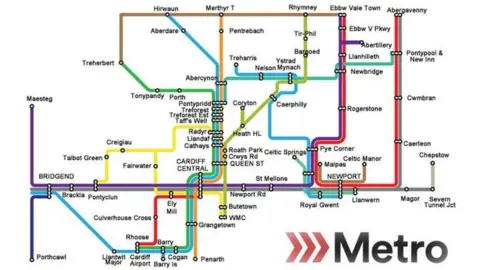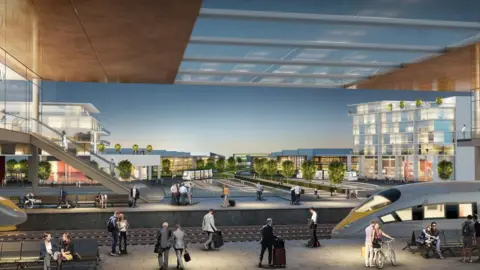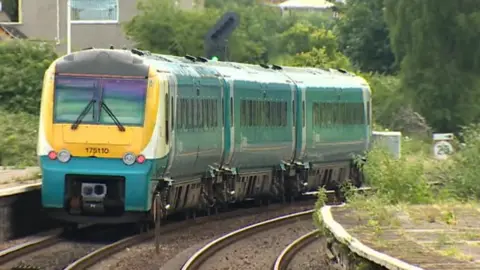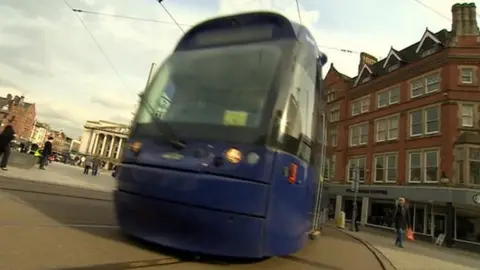Metro vision faces 'many problems' in cutting cars on roads
 Welsh government
Welsh governmentCarriages should start running on the new South Wales Metro by the mid-2020s, a transport expert has predicted.
Andrew Potter said there will be "no big bang changeover" but existing rail lines will be electrified in phases over the next decade.
Four companies are bidding to run the south Wales franchise from 2018.
Experts suggest the winner will face problems including ageing rolling stock and linking to out-lying communities.
Dr Potter, of Cardiff University, Centre for Cities' Paul Swinney, and University of South Wales' Stuart Cole have given views on how long work will take, the best modes of transport and where new stations could be built.
The four bidders - Abellio, Arriva, KeolisAmey and MTR - have been talking to the Welsh Government since June 2016.
They will soon submit final tenders for the delivery of the £600m project from 2018.
While the government will give little detail as discussions proceed, it set out broad aims with regards to stock, stations and ticketing.
Dr Potter believes the most important issue is making sure it does not just link into Cardiff but also to outer areas and large housing estates being built
However, the most pressing issue is with what to replace the ageing and much-maligned rolling stock used by current franchise holder Arriva Trains Wales.
"It's a 20-year decision and the biggest one," he said.

"Light rail offer a good, rapid system on electrified lines and is cheaper.
"The downside is, that apart from a few places, you keep them separate from heavy rail. And there is still coal coming down the Rhymney Valley line."
This is why he believes completing work in phases is the best option - electrifying the Treherbert and Aberdare lines first by about 2020.
"Things are moving away from coal and in 10 years there may not be freight trains there [on the Rhymney Valley line] anyway," he added.
"Phases will spread the cost over a longer time frame, even if you do lose the big bang changeover like in Manchester where they shut down all systems and brought trams in on all routes."
He said having all the current rail network electrified in five to 10 years "might be a bit optimistic" but "a sizeable chunk" could be completed by the mid-2020s.
After that, thoughts would turn to new stations.
Dr Potter said: "If it is light rail, you could extend from Aberdare, beyond to Tower Colliery and Hirwaun.
 Cardiff Parkway Developments Ltd
Cardiff Parkway Developments Ltd"There are also four tracks between Newport and Cardiff, two used for passenger trains and two for freight, so there is potential there.
"A new station on Newport Road could plug a gap in the city and link into services travelling to Ebbw Vale, Bristol and Manchester as well as creating a new local service to Abergavenny."
The proposed new Cardiff Parkway on the same line, near St Mellons, could feed into a growing Cardiff Airport and "a hub to the east".
Buses will also play a part, linking areas that rail cannot reach - such as a new convention centre at the Celtic Manor, for example.
However, there will be many hurdles before reaching this stage, according to Prof Cole.
"Firstly, Network Rail owns the tracks while the franchise is a partnership between the Welsh Government and a company," he said.
"Also, if the money is not available [for the vision], what do you do?"
Whether ownership of the tracks is transferred to new body Transport for Wales - set up to oversee the metro's delivery - could affect how much is electrified.

"If you keep the [current] diesel trains, Wales will be one of the only countries in the world with them on commuter routes," Prof Cole added.
"Cardiff would also be one of a few capital cities in Europe where only a small proportion of trains are electrified.
"The question is what can companies do and what is affordable?"
He agreed funding meant a limited number of routes - such as those from Treherbert and Coryton to Cardiff Central - could be electrified first.
However, this would mean people on the Treherbert to Barry trains, for example, having to change from the new vehicle on to the old train at Central station.
"That provides an opportunity for trams to be used," said Prof Cole.
"They could travel from Treherbert, come off the track somewhere after Cathays and travel past the university, museum and castle towards Central."
A second tram line could run in the opposite direction from Cardiff Bay, down Lloyd George Avenue and Westgate Street.
An outline metro map also suggests the possibility of taking light rail on existing roads around Roath Park and along Crwys Road, Cathays.

NOTTINGHAM
With a population of 321,000, it is a similar size to Cardiff and councillor Nick McDonald called its tram network "the jewel in the crown".
He said: "It goes in and out of the city at speed. It's comfortable and clean. It's a huge addition to Nottingham - something that has become emblematic."
Mr McDonald believes "a clear view" is vital in south Wales as well as recognition that the network must be built in phases over time.
He called for ambition, saying: "The larger you go, the more viable it is.
"If you're going to do it you have got to create a larger network that makes sense in terms of patronage.

"You have to make sure it goes through the right communities, connecting out to universities, hospitals and train stations."
However, there could be problems. Risks over spiralling costs were taken by contractors rather than the council, while issues, such as the position of utilities when digging "cannot be avoided".
Nottingham council also faced criticisms for being "anti-car" and he said such arguments must be countered by evidence of the benefits to businesses.

"A lot of focus goes on improving trade links between cities," said Paul Swinney, principal economist for the Centre for Cities think-tank.
"But our research shows links within city regions are more important for businesses looking to invest as they want to employ as many workers as possible."
He said trams in Nottingham and Sheffield "have not had much impact" as they have gone into some deprived areas "where people can't afford rail transport".
Mr Swinney believes "a frank conversation" needs to take place over whether buses would be the best option.
And while a fully-integrated system is still potentially a decade away, he does not see south Wales trailing other areas.
"London is some distance ahead, while Manchester and Newcastle have their own metro networks," he said.
"Birmingham is working on one but the rest are under development. Leeds doesn't have one at all despite its size and Bristol the same.
"In a UK context, Cardiff only lags some cities. However, in terms of Europe, they're some way behind other capitals."
